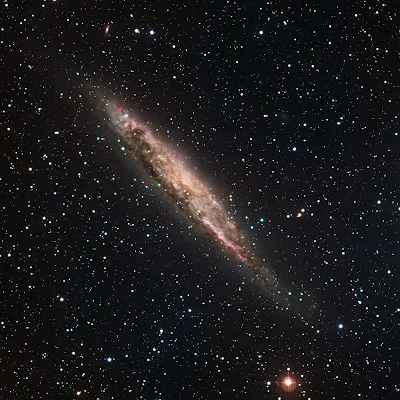Πυροτεχνήματα
δεν συμβαίνουν μόνο στον ουρανό της Γης, αλλά μπορεί να έχουν και κοσμικές
διαστάσεις. Το διαστημικό τηλεσκόπιο «Χαμπλ» ανακάλυψε ένα τέτοιο αστρικό
«σόου» σε ένα σπάνιο γαλαξία-γυρίνο, που λέγεται έτσι επειδή μοιάζει με το
προστάδιο του βατράχου. In this new image from the NASA/ESA Hubble Space Telescope,
a firestorm of star birth is lighting up one end of the diminutive galaxy LEDA
36252 — also known as Kiso 5649. The galaxy is a member of a class of galaxies
called “tadpoles” because of their bright heads and elongated tails. This
galaxy resides relatively nearby, at a distance of 80 million light-years.
Tadpoles are rare in the local Universe but common in the distant Universe,
suggesting that many galaxies pass through a phase like this as they evolve. Credit:
NASA, ESA, and D. Elmegreen (Vassar College), B. Elmegreen (IBM’s Thomas J.
Watson Research Center), J. Almeida, C. Munoz-Tunon, and M. Filho (Instituto de
Astrofisica de Canarias), J. Mendez-Abreu (University of St. Andrews), J.
Gallagher (University of Wisconsin-Madison), M. Rafelski (NASA Goddard Space
Flight Center), and D. Ceverino (Center for Astronomy at Heidelberg University)
Ο
κοσμικός «βατραχάκος» έχει ένα πολύ φωτεινό κεφάλι και μια επιμήκη ουρά,
διαφέροντας εξωτερικά από τους συνήθεις σπειροειδείς και ελλειπτικούς (οβάλ)
γαλαξίες. Στο «κεφάλι» του, που έχει μήκος 2.700 ετών φωτός, αποκαλύφθηκε μια
«έκρηξη» δημιουργίας δεκάδων νέων σμηνών άστρων, που θυμίζει εκτόξευση
πυροτεχνημάτων, αντίθετα με την πολύ πιο ήσυχη «ουρά» του.
This ground-based
image shows the tadpole galaxy LEDA 36252 and its surroundings. Credit: NASA, ESA, Digitized
Sky Survey 2
Ο
εν λόγω μικρός γαλαξίας-γυρίνος λέγεται LEDA 36252 ή Kiso 5639, βρίσκεται σε
απόσταση 82 εκατομμυρίων ετών φωτός από τη Γη και τα περισσότερα άστρα της
ουράς του είναι πολύ «γέρικα». Μάλιστα το «κεφάλι» του μοιάζει και με ελβετικό
τυρί, καθώς περιέχει ουκ ολίγες τρύπες, κενά που πιθανότατα προκλήθηκαν από
πολυάριθμες εκρήξεις υπερκαινοφανών αστέρων (σούπερ-νόβα).
Πριν
χρόνια οι αστρονόμοι είχαν ανακαλύψει ένα γαλαξία που του είχαν δώσει το όνομα
Γυρίνος, όπως και λέγεται ακόμη, όμως στην πραγματικότητα είναι σπειροειδής γαλαξίας
και δεν ανήκει στη σπάνια κατηγορία των γαλαξιών-γυρίνων.
Οι
γαλαξίες-γυρίνοι ήσαν πιο συνήθεις στο πρώιμο σύμπαν, όπου αποτελούσαν το 10%
περίπου των γαλαξιών, αλλά είναι πολύ πιο ασυνήθιστοι στο τοπικό «σύγχρονο»
σύμπαν. Εκτιμάται ότι για κάθε 10.000 κοντινούς γαλαξίες, δεν υπάρχουν
περισσότεροι από 20 γαλαξίες-γυρίνοι.
Το
διαστημικό τηλεσκόπιο Hubble αποτελεί συνεργασία της Αμερικανικής Διαστημικής
Υπηρεσίας (NASA) και του Ευρωπαϊκού Οργανισμού Διαστήματος (ESA).
Οι
ερευνητές, με επικεφαλής τη Ντέμπρα Έλμεργκριν του Κολλεγίου Βασάρ της Νέας
Υόρκης, έκαναν τη σχετική δημοσίευση για την ανακάλυψή τους στο περιοδικό
αστροφυσικής «The Astrophysical Journal».
Πηγή:
www.spacetelescope.org





